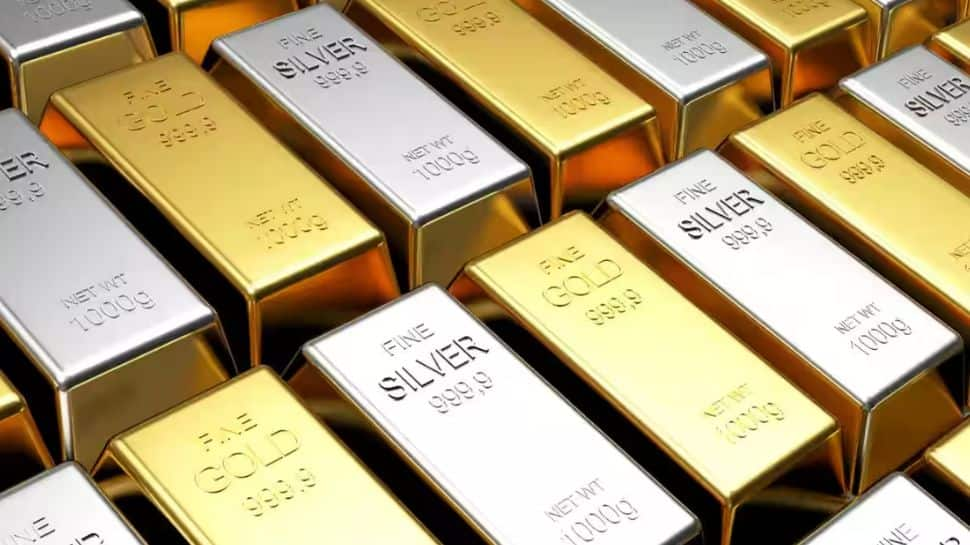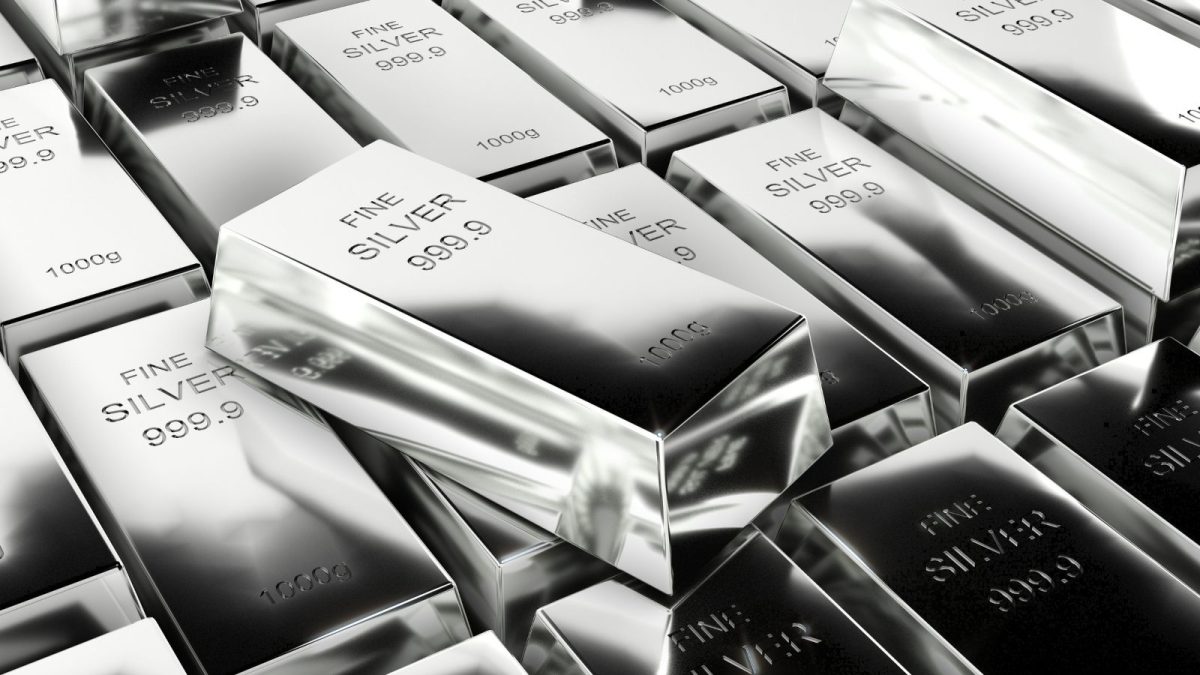Business
Gold rate today: Prices surge Rs 900 near record high; silver stays flat at Rs 1.25 lakh per kg – The Times of India

Gold rate today: Gold prices soared by Rs 900 to Rs 1,06,970 per 10 grams in the national capital on Friday, edging closer to record highs amid rupee weakness, firm global trends, and expectations of a US Federal Reserve rate cut later this month.According to the All India Sarafa Association, gold of 99.5 per cent purity also advanced by Rs 900 to Rs 1,06,100 per 10 grams (inclusive of all taxes), compared with the previous close of Rs 1,05,200. Silver prices, however, remained unchanged at Rs 1,25,600 per kg, PTI reported.“Gold rose on the last trading day of the week, fuelled by expectations of lower US interest rates and safe-haven demand. Following Thursday’s disappointing employment report, markets fully priced in a September rate cut,” said Saumil Gandhi, Senior Analyst – Commodities at HDFC Securities.He added that pessimism surrounding the Russia-Ukraine peace talks, due to lack of progress, has also boosted safe-haven demand.The rupee closed at an all-time low of Rs 88.27 against the dollar on Friday, down 15 paise amid sustained foreign fund outflows and fears of fresh US tariffs on India.In global markets, spot gold edged higher to $3,551.44 per ounce, staying close to its record high of $3,578.80 per ounce touched on Wednesday. Spot silver rose 0.22 per cent to trade at $40.76 per ounce.“The US nonfarm payroll report to be released later in the day is a crucial indicator, as it will throw more light on the job market situation and shape the Federal Reserve’s monetary policy decision,” said Praveen Singh, Head of Commodities and Currencies at Mirae Asset ShareKhan. “The Fed is now focusing more on the job market than inflation control, and a weak report will increase the chances of successive rate cuts,” he added.
Business
The giant heat pumps designed to warm whole districts
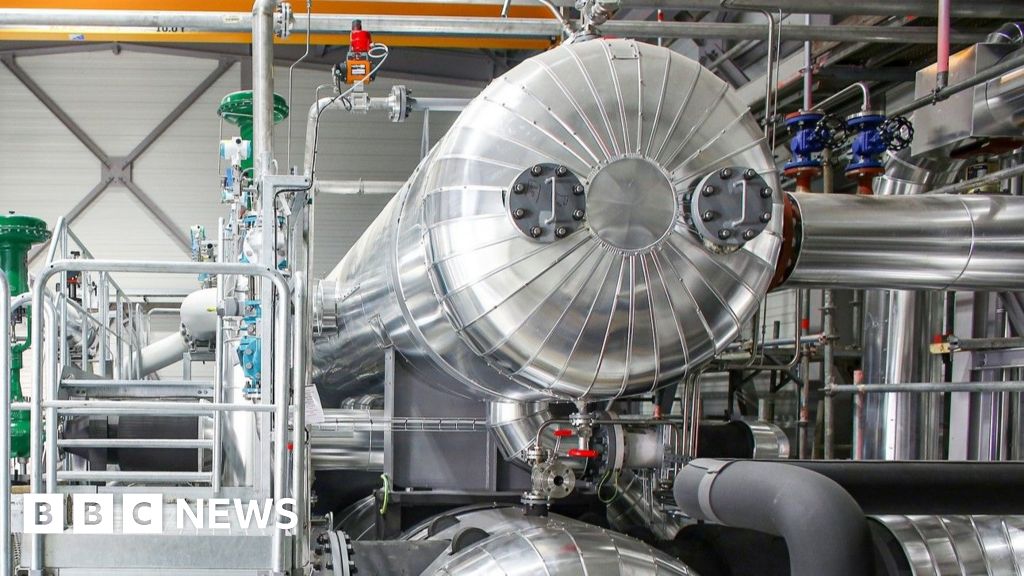
Chris BaraniukTechnology Reporter
 MVV Energie
MVV EnergieThe pipe that will supply the heat pump, drawing water from the River Rhine in Germany, is so big that you could walk through it, fully upright, I’m told.
“We plan to take 10,000 litres per second,” says Felix Hack, project manager at MVV Environment, an energy company, as he describes the 2m diameter pipes that will suck up river water in Mannheim, and then return it once heat from the water has been harvested.
In October, parent firm MVV Energie announced its plan to build what could be the most powerful heat pump modules ever. Two units, each with a capacity of 82.5 megawatts.
That’s enough to supply around 40,000 homes, in total, via a district heating system. MVV Energie aims to build the system on the site of a coal power plant that is converting to cleaner technologies.
The scale of the heat pumps was determined partly by limits on the size of machinery that could be transported through the streets of Mannheim, or potentially via barges along the Rhine. “We’re not sure about that yet,” says Mr Hack. “It might come via the river.”
One person well aware of the project is Alexandre de Rougemont, at Everllence (formerly MAN Energy Solutions), another German company that also makes extremely large heat pumps. “It is a competition, yeah,” he says. “We’re open about it.”
Heat pumps soak up heat from the air, ground or, in these cases, bodies of water. Refrigerants inside the heat pumps evaporate when they are warmed even slightly.
By compressing the refrigerant, you boost that heat further. This same process occurs in heat pumps designed to supply single homes, it just happens on a much larger scale in giant heat pumps that serve entire city districts.
As towns and cities around the world seek to decarbonise, many are deciding to purchase large heat pumps, which can attach to district heating networks.
These networks allow hot water or steam to reach multiple buildings, all connected up with many kilometres of pipe. Ever bigger models of heat pump are emerging to meet demand.
“There was a lot of pressure on us to change the heat generation to new sources, especially renewable sources,” explains Mr Hack as he discusses the decommissioning of coal-fired units at the Mannheim plant. The site is right by the Rhine, already has a hefty electricity grid connection, and is plugged in to the district heating network, so it makes sense to install the heat pumps here, he says.
He notes that the technology is possible partly thanks to the availability of very large compressors in the oil and gas industry – where they are used to compress fossil fuels for storage or transportation, for example.
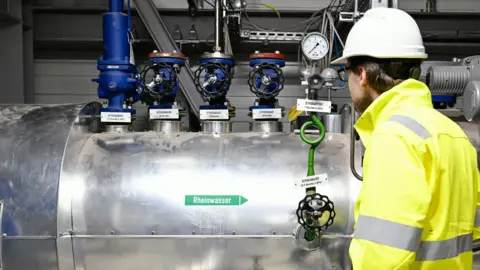 MVV Energie
MVV EnergieWork on the Mannheim project is due to start next year. The heat pumps – with a combined capacity of 162MW – are set to become fully operational in the winter of 2028-29. Mr Hack adds that a multi-step filter system will prevent the heat pumps sucking up fish from the river, and that modelling suggests the system will affect the average temperature of the river by less than 0.1C.
Installations such as this are not cheap. The Mannheim heat pump setup will cost €200m ($2.3m; £176m). Mr de Rougemont at Everllence says that, at his company, heat-pump equipment costs roughly €500,000 per megawatt of installed capacity – this does not include the additional cost of buildings, associated infrastructure and so on.
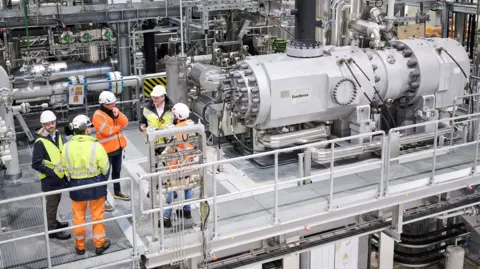 Everllence
EverllenceEverllence is currently working on a project in Aalborg, Denmark that will be even more powerful than the system in Mannheim, with a total capacity of 176MW. It will use smaller modules, however – four 44MW units – and is due to become operational in 2027, when it will supply nearly one third of all heating demand in the town.
Those 44MW machines are actually the same ones used in a previous project, now fully operational, to the south of Aalborg in Esbjerg. There, they don’t run at maximum capacity but rather supply 35MW each.
Large hot water storage tanks, each able to hold 200,000 cubic metres of liquid, will give the system added flexibility, adds Mr de Rougemont: “When the electricity price is high, you stop your heat pump and only provide heat from the storage.”
Veronika Wilk at the Austrian Institute of Technology says, “Heat pumps and district heating systems are a great fit.” Such systems can harvest heat from bodies of water or even wastewater from sewage treatment plants.
Dr Wilk notes that, when you use multiple large heat pumps on a district heating network, you gain flexibility and efficiency. You could run two out of four heat pumps in the autumn, say, when less heat is required than during the depths of winter.
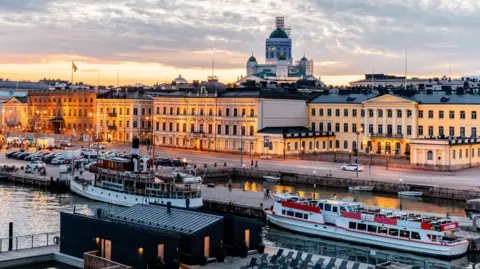 Getty Images
Getty ImagesAll the systems mentioned so far harvest energy from water sources but, less commonly, very large heat pumps can use the air as a heat source, too. Even in a relatively cold city such as Helsinki.
“The sea in front of Helsinki is too shallow,” explains Timo Aaltonen, senior vice president of heating and cooling at Helen Oy, an energy firm. “We calculated that we would need to build a tunnel more than 20km long to the ocean, to get enough water [with a] temperature high enough.”
Helsinki is in the process of radically overhauling its district heating system. The city has added heat pumps, biomass burners and electric boilers to a 1,400km network that links up nearly 90% of buildings in the Finnish capital, adds Mr Aaltonen.
Heat pumps convert single kilowatt hours of electricity into multiple kilowatt hours of heat but electric boilers can’t do this and are therefore considered less efficient.
I ask why Helen Oy decided to install hundreds of megawatts of these boilers and Mr Aaltonen says that they are cheaper to install than heat pumps and having them also means he and colleagues don’t have to rely entirely on the air, which is limited in terms of how much heat it can provide at scale. Plus, the electric boilers can help to soak up surplus renewables and provide an electricity grid-balancing function, he says.
There are no heat pumps in the UK that rival the systems under development in Denmark, Germany and Finland. However, some new district heating networks are on the way, such as the Exeter Energy Network, which will supply the University of Exeter and other customers.
The minimum planned capacity of the network is 12MW. It will feature three 4MW air-to-water heat pumps, with the first unit due to become operational in 2028.
Keith Baker at Glasgow Caledonian University, who researches district heating systems, says the UK has opportunities to make more of this technology. Water in disused mines, which maintains a relatively stable temperature, is beginning to supply larger heat pumps here, for example.
Post-industrial and rural areas where there is adequate space to install heat pumps and heat storage tanks are “the sweet spots”, he says.
Business
UK launches taskforce to ‘break down barriers’ for women in tech

The government has launched a new taskforce it says will help women “enter, stay and lead” in the UK tech sector.
Led by technology secretary Liz Kendall, it will see female leaders from tech companies and organisations advise the government on how to boost diversity and economic growth in the industry.
BCS, the Chartered Institute for IT, recently suggested women accounted for only 22% of those working in IT specialist roles in the UK.
Ms Kendall said the Women in Tech group would “break down the barriers that still hold too many people back”.
“When women are inspired to take on a role in tech and have a seat at the table, the sector can make more representative decisions, build products that serve everyone,” she said.
BCS, the Chartered Institute for IT, warned in December the amount of women working in the UK tech sector still lagged far behind men.
It said the government should look to help close the gender gap in order to meet its ambitious AI goals.
“We cannot create high-trust, high-integrity AI systems if the profession behind them is missing out on the talents and perspective of half the population,” said chief executive Sharron Gunn.
Ms Kendall will lead the taskforce alongside Anne-Marie Imafidon, founder of Stemettes, who has been appointed as the Women in Tech Envoy.
Dr Imafidon, who passed A-level computing aged 11 and received a Master’s Degree in Maths and Computer Science from the University of Oxford aged 20, has sought to encourage more young women into careers in Stem – science, technology, engineering and maths.
She told the BBC her role would build on more than a decade of work to establish greater equality for – and representation of – women.
But now, amid what she called “a fourth industrial revolution”, was a key moment to “be part of shifting who is making those decisions for what comes next”.
“This isn’t just about having women being the driving force and building the technology, but this is about building technology that benefits everybody,” she said.
The government said the taskforce will advise on ways to make the tech sector more representative and “ensure the UK accesses the full talent pool, market opportunities, and innovation capacity needed for economic growth”.
BT Group boss Allison Kirkby, Revolut chief executive Francesca Carlesi and Dr Hayaatun Sillem, chief executive of the Royal Academy of Engineering, are among its 15 founding members.
It also includes TUC assistant general secretary Kate Bell, director of public policy at Uber Emma O’Dwyer, and Sue Daley, director of technology and innovation at industry group techUK.
“Entry routes, career progression to leadership, and access to capital are just some of the barriers women in tech still face today,” Ms Daley said.
“Achieving gender equality is long overdue, and I am honoured to join the Women in Tech taskforce alongside Liz Kendall and several inspiring women from across the industry, working together to chart a path forward for true gender equality.”
Business
Frontier Airlines replaces CEO Barry Biffle with carrier’s president

Barry Biffle, president and chief executive officer Frontier Airlines, prior to a Senate Judiciary Subcommittee on Antitrust, Competition Policy, and Consumer Rights hearing in Washington, DC, US, on Tuesday, Sept. 30, 2025.
Kent Nishimura | Bloomberg | Getty Images
Frontier Group Holdings, the parent company of budget airline Frontier, replaced its nearly decade-long CEO, Barry Biffle, with the carrier’s president, the company said Monday.
James Dempsey is taking over as interim CEO effective immediately.
“Jimmy has been an invaluable member of Frontier’s senior leadership team for more than 10 years and has played an instrumental role in the company’s evolution and growth during that time,” Board Chair Bill Franke said in a news release. “We believe Jimmy is uniquely qualified to guide our airline into the future.”
Biffle and Frontier declined to comment. Frontier said Biffle would stay on in an “advisory capacity” until the end of the year.
Biffle had been Frontier’s chief executive since March 2016 and has a more than three-decade career in airlines, including at the country’s longtime top budget carrier, Spirit, which is currently in its second bankruptcy in less than a year.
Frontier lost $190 million in the first nine months of the year, compared with net income of $31 million a year earlier.
Frontier had been in talks to merge with Spirit several times since early 2022, but none have solidified thus far.
Smaller budget airlines like Frontier have struggled to produce steady profits in the wake of the pandemic, as higher labor and other costs, as well as consumer tastes shifting to international travel and higher-end seats, and an oversupply of domestic capacity, hurt financial results.
Biffle led some of Frontier’s initiatives in recent months to cater to customers seeking more space on board.
Frontier’s shares are down nearly 19% so far this year, while the NYSE Arca Airline Index, which tracks mostly U.S. airlines, is up more than 6%.
-

 Politics1 week ago
Politics1 week agoThailand launches air strikes against Cambodian military: army
-

 Politics1 week ago
Politics1 week agoZelenskiy says Ukraine’s peace talks with US constructive but not easy
-

 Politics5 days ago
Politics5 days agoTrump launches gold card programme for expedited visas with a $1m price tag
-

 Fashion1 week ago
Fashion1 week agoGermany’s LuxExperience appoints Francis Belin as new CEO of Mytheresa
-

 Tech6 days ago
Tech6 days agoJennifer Lewis ScD ’91: “Can we make tissues that are made from you, for you?”
-

 Business5 days ago
Business5 days agoRivian turns to AI, autonomy to woo investors as EV sales stall
-

 Entertainment1 week ago
Entertainment1 week agoToo big to fail? IndiGo crisis exposes risks in Indian aviation
-

 Sports5 days ago
Sports5 days agoPolice detain Michigan head football coach Sherrone Moore after firing, salacious details emerge: report



